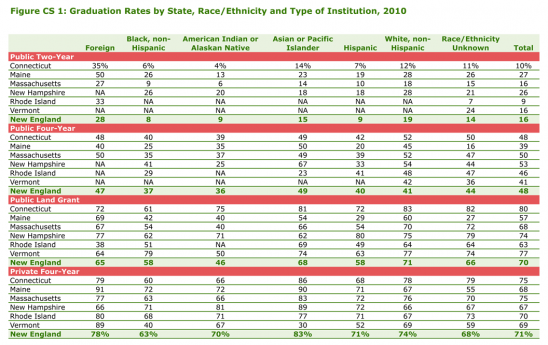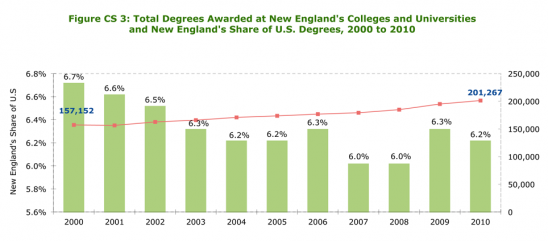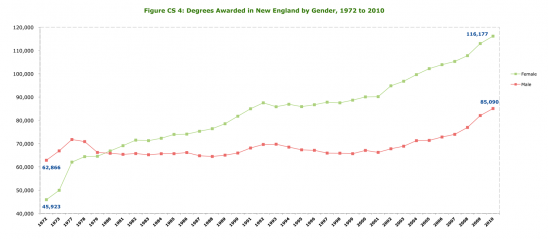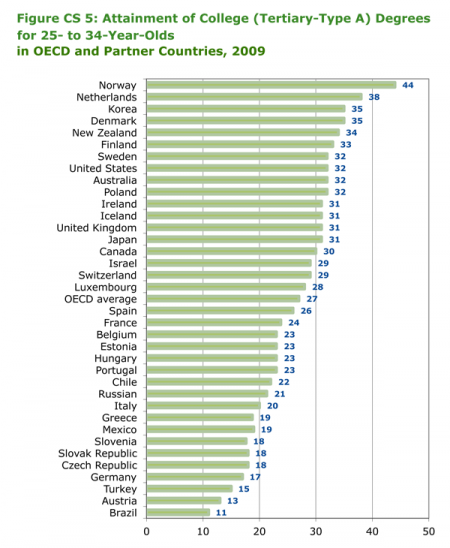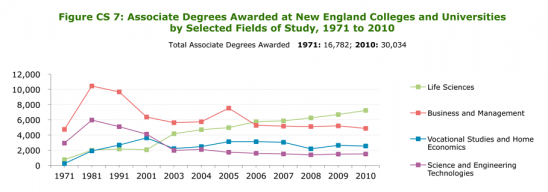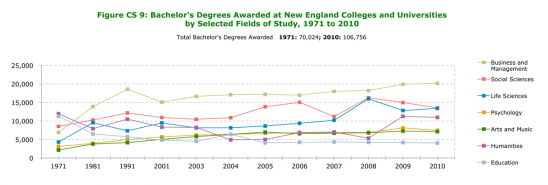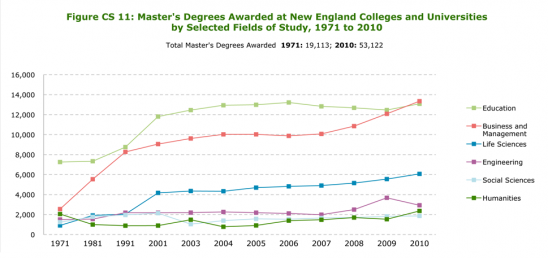Updated November 2012
New England’s traditional public and private nonprofit colleges and universities conferred more than 201,000 degrees at all levels in 2010—or more than 6% of the U.S. total, compared with the region’s less than 5% of the U.S. population. However, those traditional public and private nonprofit colleges make up an ever-smaller portion of the U.S. total, and the U.S. represents a shrinking part of the global higher education market.
Among other highlights in NEBHE’s annual update on measures of “College Success” …
- Amid national calls for increasing degree attainment, only 16% of students at New England’s traditional two-year community colleges graduate within three years of enrolling—and the rate is even lower among U.S. minority groups.
- NEBHE and other experts are refocusing attention on student transfer between institutions—and not simply from two-year to four-year institutions, but also “reverse transfer” in an age of student “swirl.”
- Nearly 60% of all higher education degrees awarded in New England are conferred on women.
For other trend data, visit our continually updated Trends & Indicators or Newslink.
Figure CS 1: Graduation Rates by State, Race/Ethnicity and Type of Institution, 2010
Click on the chart to enlarge.
Note: The graduation rate is the percentage of students who complete an associate degree (at two-year institutions) within three years, or a bachelor’s degree (at four-year institutions) within six years.
Source: New England Board of Higher Education analysis of U.S. Department of Education data.
Figure CS 2: Graduation and Transfer Rates by State and Type of Institution, 2010
Click on the chart to enlarge.
Note: The graduation rate is the percentage of students who complete an associate degree (at two-year institutions only) within three years or a bachelor’s degree (at four-year institutions) within six years. Figures are based on cohorts entering in 2002 (four-year institutions) or 2005 (two-year institutions). New England data is based on the aggregate numbers of all institutions of a given type, rather than an average of the states’ graduation rates.
Source: New England Board of Higher Education analysis of U.S. Department of Education data.
Figure CS 3: Total Degrees Awarded at New England’s Colleges and Universities and New England’s Share of U.S. Degrees, 2000 to 2010
Click on the chart to enlarge.
Source: New England Board of Higher Education analysis of U.S. Department of Education data.
Figure CS 4: Degrees Awarded in New England by Gender, 1972 to 2010
Click on the chart to enlarge.
Source: New England Board of Higher Education analysis of U.S. Department of Education data.
Figure CS 5: Attainment of College (Tertiary-Type A) Degrees for 25- to 34-Year-Olds in OECD and Partner Countries, 2009
Click on the chart to enlarge.
Note: Tertiary-type A programs are largely theory-based and designed to provide sufficient qualifications for entry to advanced research programs and roughly correspond to bachelor’s and master’s degree programs in the U.S. Advanced research programs correspond to doctorate programs.
Source: Organization for Economic Co-operation and Development, Education at a Glance: OECD Indicators 2010, Table A1.3a.
Figure CS 6: Associate Degrees Conferred on Men, Women, Minorities and Foreign Students, 2010
Click on the chart to enlarge.
Note: The graduation rate is the percentage of students who complete an associate degree (at two-year institutions) within three years, or a bachelor’s degree (at four-year institutions) within six years.
Source: New England Board of Higher Education analysis of U.S. Department of Education data.
Figure CS 7: Associate Degrees Awarded at New England Colleges and Universities by Selected Fields of Study, 1971 to 2010
Click on the chart to enlarge.
Note: Disciplines not listed include: Arts and Music, Education, Social Service Professions, Communication and Librarianship, Psychology, Social Sciences, Geosciences, Law, Interdisciplinary or other Sciences, Architecture and Environmental Design, Humanites, Religion and Theology, Math and Computer Sciences and unknown disciplines. These unlisted disciplines awarded 13,869 degrees in 2010.
Source: New England Board of Higher Education analysis of U.S. Department of Education data.
Figure CS 8: Bachelor’s Degrees Conferred on Men, Women, Minorities and Foreign Students, 2010
Click on the chart to enlarge.
Source: New England Board of Higher Education analysis of U.S. Department of Education data.
Figure CS 9: Bachelor’s Degrees Awarded at New England Colleges and Universities by Selected Fields of Study, 1971 to 2010
Click on the chart to enlarge.
Note: Data from 1971 to 2001 reflect 10-year intervals and data from 2003 to 2008 reflect one-year intervals. Disciplines not listed include: Communication and Librarianship, Math and Computer Sciences, Engineering, Vocational Studies and Home Economics, Science and Engineering Technologies, Social Service Professions, Physical Sciences, Architecture and Environmental Design, Geosciences, Religion and Theology, Interdisciplinary or other Science, Law and unknown disciplines. These unlisted disciplines awarded 29,977 degrees in 2010.
Source: New England Board of Higher Education analysis of U.S. Department of Education data.
Figure CS 10: Master’s Degrees Conferred on Men, Women, Minorities and Foreign Students, 2010
Click on the chart to enlarge.
Source: New England Board of Higher Education analysis of U.S. Department of Education data.
Figure CS 11: Master’s Degrees Awarded at New England Colleges and Universities by Selected Fields of Study, 1971 to 2010
Click on the chart to enlarge.
Note: Data from 1971 to 2001 reflect 10-year intervals and data from 2003 to 2008 reflect one-year intervals. Disciplines not listed include: Physcial Science, Geosciences, Math and Computer Science, Psychology, Science and Engineering Technologies, Interdisciplinary or other Sciences, Religion and Theology, Arts and Music, Architecture and Environmental Design, Communication and Librarianship, Law, Social Service Professions, Vocational Studies and Home Economics and unknown disciplines. These unlisted disciplines awarded 13,460 degrees in 2010.
Source: New England Board of Higher Education analysis of U.S. Department of Education data.
Figure CS 12: Doctorates Conferred on Men, Women, Minorities and Foreign Students, 2010
Click on the chart to enlarge.
Note: Includes all doctorate degrees, doctorate degree professional practice, doctorate degree research/scholarship and other doctorate degrees.
Source: New England Board of Higher Education analysis of U.S. Department of Education data.
Figure CS 12a: Doctorate Research and Scholarship Degrees Conferred on Men, Women, Minorities and Foreign Students, 2010
Click on the chart to enlarge.
Note: A Ph.D. or other doctor’s degree that requires advanced work beyond the master’s level, including the preparation and defense of a dissertation based on original research, or the planning and execution of an original project demonstrating substantial artistic or scholarly achievement. Some examples of this type of degree may include Ed.D., D.M.A., D.B.A., D.Sc., D.A., or D.M, and others, as designated by the awarding institution.
Source: New England Board of Higher Education analysis of U.S. Department of Education data.
Figure CS 12b: Doctorate Professional Practice Degrees Conferred on Men, Women Minorities and Foreign Students, 2010
Click on the chart to enlarge.
Note: A doctor’s degree that is conferred upon completion of a program providing the knowledge and skills for the recognition, credential, or license required for professional practice. The degree is awarded after a period of study such that the total time to the degree, including both pre-professional and professional preparation, equals at least six full-time equivalent academic years. Some of these degrees were formerly classified as “first-professional” and may include: Chiropractic (D.C. or D.C.M.); Dentistry (D.D.S. or D.M.D.); Law (L.L.B. or J.D.); Medicine (M.D.); Optometry (O.D.); Osteopathic Medicine (D.O); Pharmacy (Pharm.D.); Podiatry (D.P.M., Pod.D., D.P.); or, Veterinary Medicine (D.V.M.), and others, as designated by the awarding institution.
Source: New England Board of Higher Education analysis of U.S. Department of Education data.
Figure CS 12c: Other Doctorates Conferred on Men, Women, Minorities and Foreign Students, 2010
Click on the chart to enlarge.
Note: A doctorate degree that does not meet the definition of a doctorate degree-research/scholarship or a doctorate degree-professional practice. An example would be doctorate degrees awarded in a single subject non-education field.
Source: New England Board of Higher Education analysis of U.S. Department of Education data.
[ssba]

